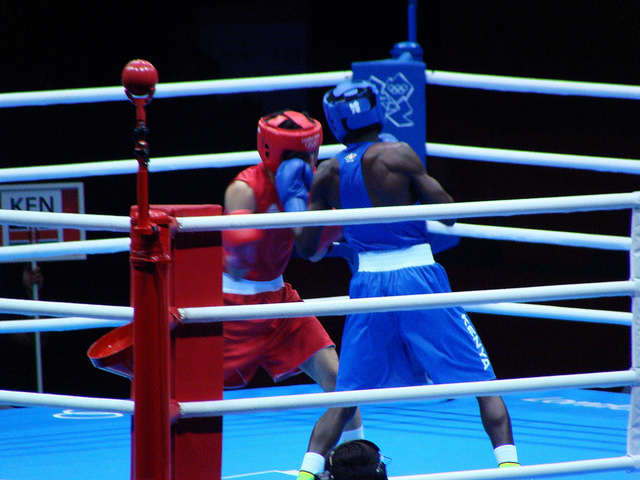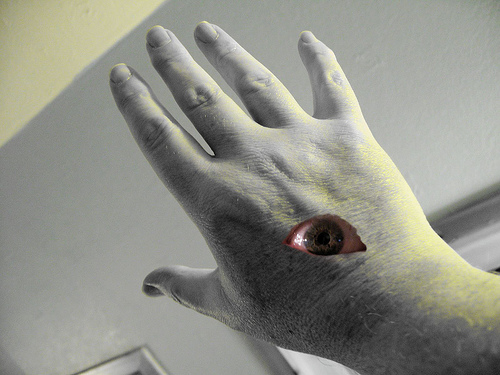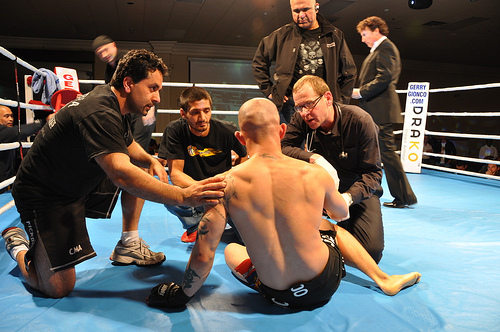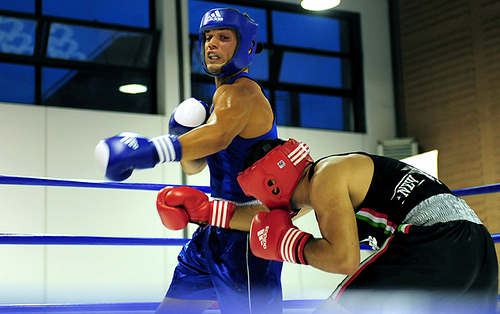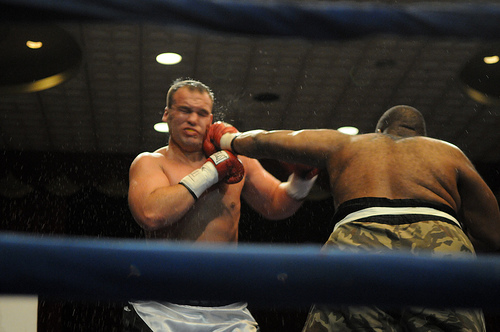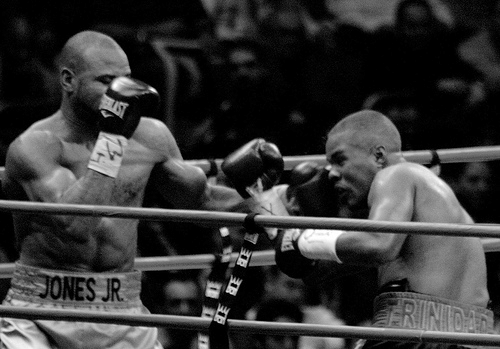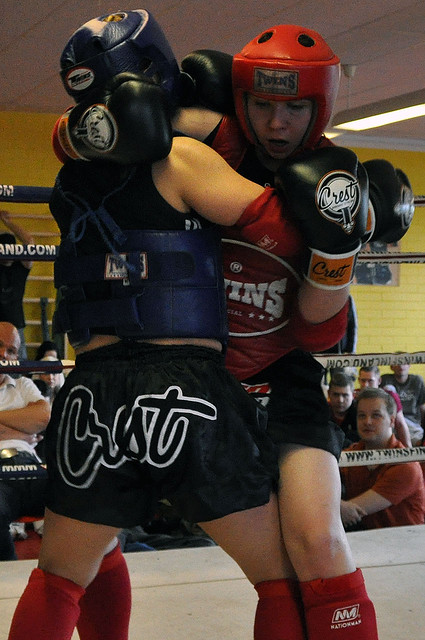Dennis recently asked a question:
Dennis recently asked a question:
Is it possible to explain how the hand is quicker1 than the eye and how to deal with the punch you cannot see coming? Your defense must be good of course but how do you take advantage of this physiological fact? I assume that combinations and power punching produce this knock out punch.
Is it possible to explain how the hand is quicker1 than the eye and how to deal with the punch you cannot see coming? Your defense must be good of course but how do you take advantage of this physiological fact? I assume that combinations and power punching produce this knock out punch.
It's a great question, so for everyone's benefit, let's break this into two parts:
- Whether or not the hand is actually quicker than the eye; and
- How do you see punches coming so you can defend against them or use them in your offence.
It's a great question, so for everyone's benefit, let's break this into two parts:
- Whether or not the hand is actually quicker than the eye; and
- How do you see punches coming so you can defend against them or use them in your offence.
Is the hand really quicker than the eye?
Is the hand really quicker than the eye?
It might seem like the hand is quicker than the eye sometimes but the answer is no.
The human eye can detect movement discontinuities up to 60 frames per second. Your hands certainly cannot move that fast.
You don't have to take my word for it - put a nickel on the table in front of you and try to move it half an inch without your eye tracking it. You'll always see the movement.
Wave your hands in front of your face as fast as you can. No matter how fast you think you can move your hands, you'll never be able to move them so fast that they disappear in front of you. Your eyes track them from position to position and they may blur into a trail of hands, but they won't disappear.
Some may argue that magicians are able to carry out a number of their tricks because the hand is faster than the eye. That is a myth. In reality, magicians are really good at slight of hand or deception that makes it appear as if something appears out of nowhere.
Boxers could learn a thing or two from magicians with regards to feinting. They are masters at pulling your attention in one direction to make something appear elsewhere.
As far as boxing goes - it's a good thing that the hand is not quicker than the eye because if you can see it, you can do something about it.
It might seem like the hand is quicker than the eye sometimes but the answer is no.
The human eye can detect movement discontinuities up to 60 frames per second. Your hands certainly cannot move that fast.
You don't have to take my word for it - put a nickel on the table in front of you and try to move it half an inch without your eye tracking it. You'll always see the movement.
Wave your hands in front of your face as fast as you can. No matter how fast you think you can move your hands, you'll never be able to move them so fast that they disappear in front of you. Your eyes track them from position to position and they may blur into a trail of hands, but they won't disappear.
Some may argue that magicians are able to carry out a number of their tricks because the hand is faster than the eye. That is a myth. In reality, magicians are really good at slight of hand or deception that makes it appear as if something appears out of nowhere.
Boxers could learn a thing or two from magicians with regards to feinting. They are masters at pulling your attention in one direction to make something appear elsewhere.
As far as boxing goes - it's a good thing that the hand is not quicker than the eye because if you can see it, you can do something about it.
Seeing Punches
Seeing Punches
When your opponent throws a punch at you it is either going to come straight on (like a jab or straight right) or from an angle (hooks and uppercuts).
Of the two - the straight on punches are harder to see coming and leave less time for reaction.
That's because punches thrown straight at you are more difficult for your eyes and brain to recognize compared to a punch coming from the side.
Your eyes are made of cones and rods. The rods are responsible for picking up movement and are concentrated in your peripheral vision. Rods are also more light sensitive and allow you to pick up dimmer objects.
You can test this yourself by heading outside at night and looking at a starry sky. If you stare directly at some stars - they disappear but if you don't concentrate on them or use your peripheral vision to look at them they will reappear.
In terms of your own offense, hopefully you see the advantage here in throwing jabs and straights straight out from your chin and back. If the punch is in line with the eye it bypasses the motion detecting rods in your opponent's peripheral vision making it much more difficult to detect and react to. You stand a much better chance at landing a punch that is thrown directly in line with your opponent's vision.
The ability to better detect motion with your peripheral vision is also the reason why, as a boxer, you shouldn't be looking directly at your opponent's hands. In fact, you shouldn't be trying to focus on anything in particular at all. You will be much faster and see much more when you adopt the "thousand yard stare" and/or stop focusing directly on your opponent.
Your guard position helps you do this automatically. With your head bent forward and tucked into your shoulder protecting your chin, you are looking up through your eyebrows. If you don't strain your eyes up to look at your opponent, they are naturally out of the direct line of sight of the punches and you will pick up on movement much more easily.
From there it's a matter of drill and instinct. If you have trained enough and prepared your reflexes your reaction time should already be pretty good. You'll react in certain ways to certain punches - on instinct you will slip, catch, parry, or block whether your brain consciously registers the incoming punch or not.
Being able to detect movement earlier gives you more time to react. Put instinct and early movement detection together and suddenly you're moving faster than the Flash.
When your opponent throws a punch at you it is either going to come straight on (like a jab or straight right) or from an angle (hooks and uppercuts).
Of the two - the straight on punches are harder to see coming and leave less time for reaction.
That's because punches thrown straight at you are more difficult for your eyes and brain to recognize compared to a punch coming from the side.
Your eyes are made of cones and rods. The rods are responsible for picking up movement and are concentrated in your peripheral vision. Rods are also more light sensitive and allow you to pick up dimmer objects.
You can test this yourself by heading outside at night and looking at a starry sky. If you stare directly at some stars - they disappear but if you don't concentrate on them or use your peripheral vision to look at them they will reappear.
In terms of your own offense, hopefully you see the advantage here in throwing jabs and straights straight out from your chin and back. If the punch is in line with the eye it bypasses the motion detecting rods in your opponent's peripheral vision making it much more difficult to detect and react to. You stand a much better chance at landing a punch that is thrown directly in line with your opponent's vision.1
The ability to better detect motion with your peripheral vision is also the reason why, as a boxer, you shouldn't be looking directly at your opponent's hands. In fact, you shouldn't be trying to focus on anything in particular at all. You will be much faster and see much more when you adopt the "thousand yard stare2" and/or stop focusing directly on your opponent.
Your guard position helps you do this automatically. With your head bent forward and tucked into your shoulder protecting your chin, you are looking up through your eyebrows. If you don't strain your eyes up1 to look at your opponent, they are naturally out of the direct line of sight of the punches and you will pick up on movement much more easily.
From there it's a matter of drill and instinct. If you have trained enough and prepared your reflexes your reaction time should already be pretty good. You'll react in certain ways to certain punches - on instinct you will slip, catch, parry, or block whether your brain consciously registers the incoming punch or not.
Being able to detect movement earlier gives you more time to react. Put instinct and early movement detection together and suddenly you're moving faster than the Flash.
But That's Not All - Bonus Detection
But That's Not All - Bonus Detection
Punches do not originate in the hands if thrown correctly. They rise up from the ground - loading through the legs - accelerating through the hips - torquing with the torso - flowing through the shoulder and extending arm and out the fist.
So if that's the case, why would you focus directly on the hands if you want to see a punch coming?
You shouldn't. Forget the hands unless you are just starting out and are trying to figure out how things work.
Learn to look at your opponent's chest - actually get into a trance and stare right through the chest. It's kind of look looking at one of those 3D pictures made out of patterns. If you look straight at it, you see a bunch of meaningless colors. Stare through it (indirectly) and the image pops off the page.
Try this one out:
Punches do not originate in the hands if thrown correctly. They rise up from the ground - loading through the legs - accelerating through the hips - torquing with the torso - flowing through the shoulder and extending arm and out the fist.
So if that's the case, why would you focus directly on the hands if you want to see a punch coming?
You shouldn't. Forget the hands unless you are just starting out and are trying to figure out how things work.
Learn to look at your opponent's chest - actually get into a trance and stare right through the chest. It's kind of look looking at one of those 3D pictures made out of patterns. If you look straight at it, you see a bunch of meaningless colors. Stare through it (indirectly) and the image pops off the page.
Try this one out:

Do You See the Shark?
Focusing on a spot a couple of feet behind and through the center of your opponent's chest allows your peripheral vision to not only pick up movement of the hands, but also the legs and hips giving you even more time to react. The twisting or loading of the hips is a sure sign that a punch is about to come.
Over time all these subtle little cues will act as triggers that will cue up and play a certain boxing drill or maneuver to allow you to deal with whatever is coming. It just takes lots of experience of practice.
Focusing on a spot a couple of feet behind and through the center of your opponent's chest allows your peripheral vision to not only pick up movement of the hands, but also the legs and hips giving you even more time to react. The twisting or loading of the hips is a sure sign that a punch is about to come.
Over time all these subtle little cues will act as triggers that will cue up and play a certain boxing drill or maneuver to allow you to deal with whatever is coming. It just takes lots of experience of practice.
How to Practice Seeing the Punches?
How to Practice Seeing the Punches?
Learning to see punches is one of the best things about becoming a good boxer. I can tell you that for a long time, I would get hit and wonder where the hell the punches came from.
As time progressed and my training made my reflexes more instinctual things got better. Then I discovered the wonders of peripheral vision and it was like someone took off the blindfold.
The punches started to appear. I still vividly remember the day in the ring when everything suddenly seemed to slow down. It was exactly like in the movie The Matrix - the punches were coming and I was reacting without thinking. I could "see" everything flowing around me. It was incredibly surreal and you can experience it too.
Obviously the best way to practice is to get someone to throw punches at you. Start slow and start with one defensive technique. This will be an exercise that develops your instincts as well as giving you some practice not focusing on your opponent's hands.
As an example - have your partner throw jabs, slow to start and speed them up as you go. You parry with your right (orthodox boxers). Don't think about it - just do it. Stare beyond your oppone1nt and just let yourself react out of instinct.
As you master one technique and are up to a decent speed, introduce another technique. Again, start slow and speed it up taking your mind out of the equation.
It comes with practice and you'll soon find yourself able to stand in front of someone throwing punches at you and your hands will automatically be parrying, blocking, catching as you slip left and right. It really is amazing and you're going to love the feeling when it happens.
Learning to see punches is one of the best things about becoming a good boxer. I can tell you that for a long time, I would get hit and wonder where the hell the punches came from.
As time progressed and my training made my reflexes more instinctual things got better. Then I discovered the wonders of peripheral vision and it was like someone took off the blindfold.
The punches started to appear. I still vividly remember the day in the ring when everything suddenly seemed to slow down. It was exactly like in the movie The Matrix - the punches were coming and I was reacting without thinking. I could "see" everything flowing around me. It was incredibly surreal and you can experience it too.
Obviously the best way to practice is to get someone to throw punches at you. Start slow and start with one defensive technique. This will be an exercise that develops your instincts as well as giving you some practice not focusing on your opponent's hands.
As an example - have your partner throw jabs, slow to start and speed them up as you go. You parry with your right (orthodox boxers). Don't think about it - just do it. Stare beyond your oppone1nt and just let yourself react out of instinct.
As you master one technique and are up to a decent speed, introduce another technique. Again, start slow and speed it up taking your mind out of the equation.
It comes with practice and you'll soon find yourself able to stand in front of someone throwing punches at you and your hands will automatically be parrying, blocking, catching as you slip left and right. It really is amazing and you're going to love the feeling when it happens.

